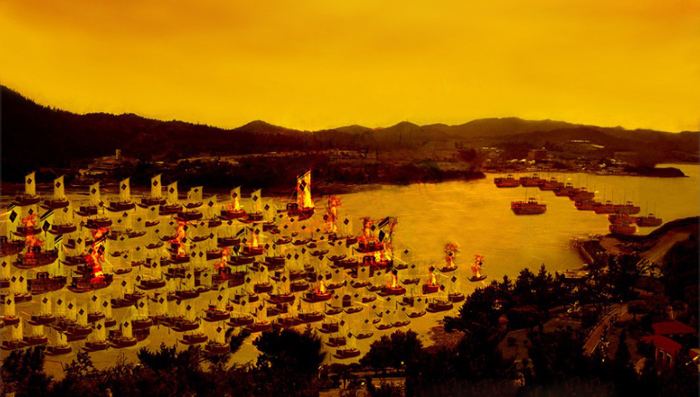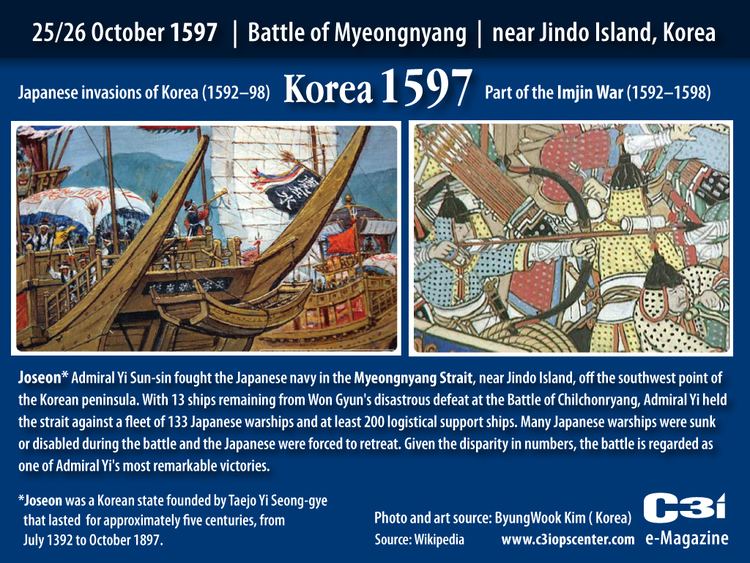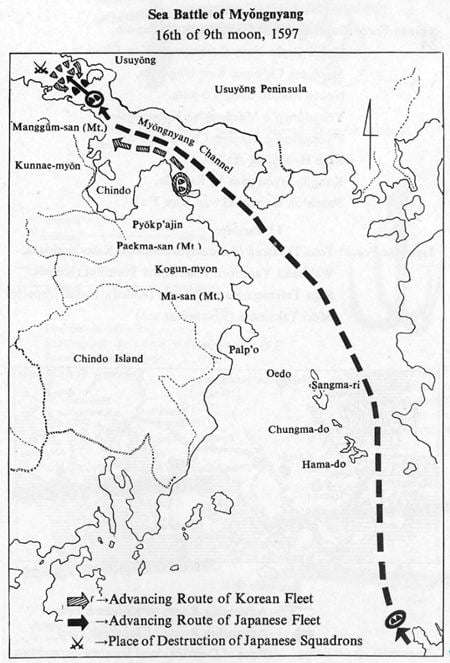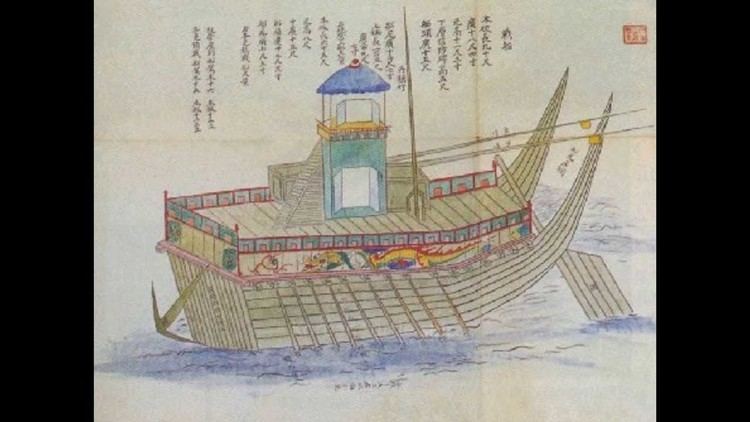330 ships
(roughly 130 warships) 13 ships Result Decisive Joseon Victory | Date 26 October 1597 | |
 | ||
Location Myeongryang Strait, South Korea Similar Japanese invasions of Korea, Battle of Noryang, Battle of Hansan Island, Battle of Chilcheollyang, Siege of Haengju | ||
In the Battle of Myeongryang, on October 26, 1597, the Korean Joseon kingdom's navy, led by Admiral Yi Sun-sin, fought the Japanese navy in the Myeongnyang Strait, near Jindo Island, off the southwest corner of the Korean peninsula.
Contents
- Background
- Prelude
- Preparation
- First phase north flowing current
- Second phase south flowing current
- The official record of Todo Takatora
- Aftermath
- References

With only 12 ships remaining from Admiral Won Gyun's disastrous defeat at the Battle of Chilchonryang, Admiral Yi held the strait as a "last stand" battle against the Japanese Navy, who were sailing to support their land army's advance towards the Joseon capital of Hanyang (modern-day Seoul).

The actual numeric strength of the Japanese fleet that Admiral Yi fought is unclear; various sources indicate the number of Japanese ships could have been anywhere between 120 to 330 ships, though the low end of this range appears to be a count of actual warships and the high end appears to be referring to the entire Japanese fleet (including roughly 200 supporting non-combatant ships). Regardless of the size of the Japanese fleet, all sources indicate that the Japanese ships heavily outnumbered the Korean ships, by at least a ten-to-one ratio. In total 30 Japanese warships were sunk or crippled during the battle. Todo Takatora, the commander of the Japanese navy, was wounded during the battle and half of his subordinate officers were also wounded or killed. Given the disparity in numbers of ships, the naval battle is regarded as one of Admiral Yi's most remarkable victories, and a humiliating naval defeat for the Japanese. Even after the victory, however, the Joseon navy was still outnumbered by the remaining Japanese navy, so Admiral Yi withdrew to the Yellow Sea to resupply his fleet and have more space for a mobile defense. After the Korean navy withdrew, the Japanese navy made an incursion into the western coast of Korea, near some islands in Yeonggwang County.

Background

Due to Japanese intrigue taking advantage of the fractious politics of the Joseon Dynasty court, Admiral Yi Sun-sin was impeached and almost put to death. Yi was instead tortured and demoted to the rank of a common soldier. Yi's rival, Admiral Won Gyun, took command of the Joseon fleet, which under Yi's careful management had grown from 63 heavy warships to 166.

Won Gyun was an incompetent military commander who immediately began squandering the Joseon Navy's strength through ill-conceived maneuvers against the Japanese naval base at Busan. In the Battle of Chilchonryang, the Japanese navy, with Todo Takatora in overall command, outmaneuvered the Joseon navy and virtually wiped it out. Soon afterwards, the Japanese reinforced their garrisons in Busan and various forts in the southern coast of Korea, and began the second invasion.

With the Joseon navy taken out of the scene, the Japanese believed that they now had free access to the Yellow Sea and could resupply their troops through this sea route as they advanced northward. In the 1592 campaigns, Admiral Yi prevented the Japanese from resupplying their troops in this manner and kept their ships holed up at their main bases in Busan harbor.
The Japanese had started the second war and renewed their offensive, laying siege and capturing the city of Namwon in September 26 and fighting the Ming Chinese army to a standstill in Jiksan on September 7. The Japanese army then awaited supplies and reinforcements from their navy, who would need to enter the Yellow Sea to reach the western coast of Korea. The army, thus supported by their navy, planned to make a major push to recapture Hanyang (modern Seoul).
Prelude
Admiral Yi Sun-sin was hastily reinstated as Supreme Commander of the Regional Navies after Won Gyun was killed at the Battle of Chilchonryang. Yi initially only had 10 panokseon ships at his disposal, which had been saved by Gyeongsang Right Naval Commander Bae Seol, who retreated early in the Battle of Chilchonryang. Bae Seol had originally saved 12 ships, but lost two while on his retreat towards Hoeryongpo. Two ships were brought by newly appointed Jolla Right Naval Commander Kim Eok-chu, and by the time of the battle, Yi had acquired another warship, likely one of the two that Bae Seol had previously lost. Thus, in total, Yi had 13 warships. Although Yi only found 120 men initially, some of the survivors of Chilchonryang rallied to him, and he had at least 1,500 sailors and marines by the end of September.
At that time, King Seonjo, who judged that the Joseon navy had lost its power and would never be restored again, sent a letter to abolish the navy and have its men join the ground forces under General Kwon Yul. Admiral Yi responded with his own letter, stating: "Even though our navy is small, as long as I live the enemy cannot despise us."
Before the main body of the Japanese navy advanced into the Yellow Sea, they sent out a few probing missions with armed scouting parties. At this time, Admiral Yi's fleet was south of the Myeongnyang Strait near Oranpo. In October 8, an advanced scouting party of eight Japanese vessels staged a surprise attack, which the Joseon fleet drove off. Yi retreated further north to Byeokpajin, on the northern end of Jindo island. On October 12, Bae Seol fled (he would be found later by Joseon authorities and executed for desertion). On October 17, a Japanese scouting fleet of 13 ships launched a night attack which, after heavy fighting, was also repulsed.
By this time, through the reports of their scouting forces, the Japanese were aware of the presence of Joseon naval remnants that intended to resist their advance. Well armed scouting forces alone were not going to defeat or scatter the Joseon remnants, so the Japanese began amassing a much larger fleet. Admiral Yi's diary mentions reports of around 55 Japanese ships massing near Oranpo on October 17. With Japanese naval activity increasing, Admiral Yi did not want to fight a major battle with his back to the Myeongnyang Strait, so on October 25 he decided to withdraw further north and hide his ships in the shadow of the hills on the opposite (northern) side of the Myeongnyang Strait, near Usuyeong (우수영).
Preparation
Admiral Yi studied numerous sites for his last stand with the Japanese navy and decided on luring them into the Myeongryang Strait. The Japanese would clearly enter the strait when the tide was favorable; thus, he didn't want to fight south of the strait, with the current at the attacker's advantage. Instead he wanted to fight in the waters just north of the strait, where the currents were calmer. The strait had very strong currents that flowed at approximately 10 knots, first in one direction, then in the opposite direction, in three hour intervals. Admiral Yi realized he could use this unique condition as a force multiplier. The narrowness of the strait would prevent the Joseon fleet from being flanked by the numerically superior enemy fleet, and the roughness of the currents prevented the Japanese from effectively maneuvering, forcing them to attack in smaller groups, and made it difficult to close in with the Korean ships. Furthermore, once the tide changed the flow of the current would in effect push the Japanese away from Yi's fleet and the momentum could be harnessed to increase the effectiveness of a counterattack.
First phase (north flowing current)
Early in the morning of October 26, the huge Japanese fleet was spotted by Yi's scouts as they deployed around the small bay on the southern end of Myeongnyang strait. Admiral Yi's fleet then redeployed out of their base in Usuyeong to block the northern end of the strait. Yi described about "...200 enemy ships... flowing [into the strait]" and at least 133 ships in his immediate vicinity. It is estimated that at least 133 ships were combat warships and at some 200 ships immediately behind were logistical (supply and troop carrying) support ships. In Japanese records, the ships at the front of their formations were the middle class warships called Seki-bune, as the Japanese fleets by this time understood the devastating offensive capabilities of the main Korean warships which were near the strait.
Yi's warships deployed on the northern end of the strait and dropped anchor. Yi in his flagship advanced upon the vanguard of the Japanese fleet, which was commanded by Kurushima Michifusa. For a time only the flagship fought in the battle. The crews of the Joseon fleet were made up of survivors from Chilchonryang and they were still badly shaken up and intimidated by the overwhelming size of the Japanese fleet. Yi said in his diary: "My flagship was alone facing the enemy formation. Only my ship fired cannons and arrows. None of the other ships advanced, so I could not assure our outcome. All other officers were seeking to run, as they knew this battle was against a massive force. Ship commanded by Kim Eok-chu, the Officer of Jeolla Right province, was at 1 majang (approximately 2–3 km) away." For a time it looked like Yi's flagship was "... standing like a castle in the middle of the sea."
The flagship's ability to hold out against the Japanese vanguard eventually gave heart to the rest of Yi's fleet and small groups of his ships came to his aid. First came a ship commanded by local magistrate An Wi and then several ships commanded by central squadron leader Kim Ung-ham. Seeing the success of the flagship and the handful of other boats, the rest of Yi's fleet joined in the fight.
Second phase (south flowing current)
The tide soon shifted and the Japanese ships began to drift backwards and collide with each other. In the confusion, Admiral Yi ordered his ships to advance and press the attack, ramming 30 Japanese ships. The dense formation of Japanese ships crowded in the narrow strait made a perfect target for Joseon cannon fire. The strong tides prevented those in the water from swimming to shore, and many Japanese sailors who abandoned sinking or damaged ships drowned in the currents. By the end of the battle, approximately 30 Japanese warships were sunk. Some Korean documents record the number of damaged Japanese warships, which also includes those not sunk but sustaining some amount of damage; however, the condition of the damaged ships is unclear.
The official record of Todo Takatora
The official record of Todo Takatora, who was the commander of the Japanese fleet, summarized this battle as a decisive defeat:
"御歸陣被成候 ちとまへかとにこもかいへ御こしなされ候 処にすいえんと申所にはん舟の大しやう分十三そうい申候 大川のせよりはやきしはのさし引御さ候 所の內にちとしほのやハらき申候 所に十三そうのふねい申候 それを見付是ともとり可よし舟手と御相にてはいまのせとをこきくたし候 儀はなるましきとていつれもせきふねを御かゝり被成 さき手のふねともハ敵船にあひ手負あまたいてき申候 中にも來島出雲守殿うちしににて御座候 其外ふね手の重めしつれられ候 からうのもの共もくわはん手負討死仕候 処に 毛利民部大夫殿せき舟にて、はんふねへ御かゝり成候。 はん船へ十文字のかまを御かけ候処に、 はん船より弓鉄砲はけしくうち申候に付、 船をはなれ海へ御はいりなされ、あやうく候 処に、藤堂孫八郎、藤堂勘解由両人船をよせ、敵船をおいのけ、たすけ申候。 朝の五しふんより酉の刻まて御合戰にて御座候 みなとのやうすはん船能存候に付風を能見すまし 其せと口をめけほをひきかけはしらせ申について是非なくおつかけ申儀もまかいならす いつみ樣も手を二か所おはせられ候."
This can be translated as follows:
"We came back to the camp. There were 13 Joseon ships in the sea. It is the whirlwind sea, but 13 ships stood there while it had calmed. We decided to fight with them. The width of the sea is too narrow so that we prepared Sekibune and started the battle. Starting the battle, lots of our people got wounded. And sir Kurushima Michifusa was killed. Also, lots of our people got captured. Half of my subordinates officers were wounded or killed. Mori attacked the enemy's ship riding on a Sekibune. To get aboard to the enemy's ship, we threw sickles. But the enemy shot the arrows and bullets fiercely, so he got endangered. Todo Songhachiro, Todo Kanggaiu's ships pushed the enemy's ship and saved him. We fought from morning till night. We ran out of the narrow sea hoisting a sail. Because of that fact, the enemy's ships could not chase us. Izzumi (Todo Takatora) got wounded in his arms."
Aftermath
The immediate results of the battle were a shock to the Japanese command. Without being resupplied or reinforced, the morale of the Japanese soldiers declined. Joseon and Ming armies were able to regroup. Even after the victory, however, the Joseon navy was still outnumbered by the remaining Japanese navy, so Admiral Yi withdrew to the Yellow sea to resupply his fleet and have more space for mobile defense. After hearing the news of the heroic victory, many surviving ships and sailors who had been hiding after the defeat at Chilcheollyang joined Admiral Yi's fleet.
The victory also enabled the Chinese navy to join Admiral Yi in early 1598. After the destruction of most of the Joseon fleet at Chilcheollyang, the Ming kept their navy stationed at important port cities to guard against possible Japanese naval attacks. The victory at Myeongnyang convinced the Ming government that they could ease security at their major ports and deploy a fleet to the Joseon navy's aid.
The Japanese navy was heavily damaged (while at least 30 of the Japanese fighting ships were destroyed, the total number of damaged ships, to include those supporting ships that may have sustained damage, was not clearly reported). As previously mentioned, Kurushima was killed & beheaded, and Todo Takatora (the hero of Chilcheollyang) was wounded. According to the Annals of the Joseon Dynasty, half of the Japanese sailors and marines were casualties.
Due to the Korean victory, after the Korean navy withdrew, even though the Japanese navy made an incursion into the western coast of Korea, near some islands of Yeonggwang County, they withdrew soon afterwards.
